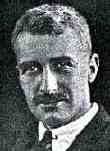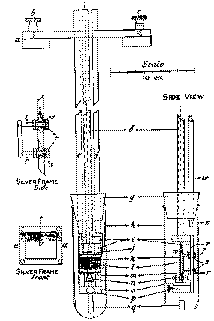|
Archibald Vivian Hill (1886-1977)
 A brilliant student
at Trinity and Kings Colleges, Cambridge, England, A.V. Hill attracted
the notice of two eminent physiologists. W. M. Fletcher and (Sir) F.
G. Hopkins (Nobel Prize in Physiology or Medicine, 1929) convinced Hill
to pursue advanced studies in physiology rather than mathematics. Hill's
early experiments researched the effects of electrical stimulation on
nerve function, the mechanical efficiency of muscle, energy processes
in muscle during recovery, the interaction between oxygen and hemoglobin,
and quantitative aspects of drug kinetics on muscle. Hill used his background
in mathematics to explain the results. Later, Hill devised mathematical
models describing heat production in muscle, and applied kinetic analysis
to explain the time course of oxygen uptake during both exercise and
recovery. Hill combined aspects of physics and biology, a discipline
which he championed as biophysics (Hill, 1931). A brilliant student
at Trinity and Kings Colleges, Cambridge, England, A.V. Hill attracted
the notice of two eminent physiologists. W. M. Fletcher and (Sir) F.
G. Hopkins (Nobel Prize in Physiology or Medicine, 1929) convinced Hill
to pursue advanced studies in physiology rather than mathematics. Hill's
early experiments researched the effects of electrical stimulation on
nerve function, the mechanical efficiency of muscle, energy processes
in muscle during recovery, the interaction between oxygen and hemoglobin,
and quantitative aspects of drug kinetics on muscle. Hill used his background
in mathematics to explain the results. Later, Hill devised mathematical
models describing heat production in muscle, and applied kinetic analysis
to explain the time course of oxygen uptake during both exercise and
recovery. Hill combined aspects of physics and biology, a discipline
which he championed as biophysics (Hill, 1931).
During World War I, Hill directed a laboratory and published technical
reports on anti-aircraft defense (Katz, 1986). After the
war, Hill achieved international acclaim for research in muscle physiology.
In 1920, he left Cambridge to Chair the Physiology Department at Manchester
University. In newly refurbished laboratories, Hill expanded his work
on muscle physiology in animals which resulted in a book on muscular
activity (Hill, 1926). Hill shared the Nobel Prize in Physiology or
Medicine in 1922 with German chemist Otto Meyerhof for discoveries about
the chemical and mechanical events in muscle contraction.
| Thermopile for measuring the heat production
in the frog's sartorius muscle.
 "A resting muscle placed upon it and
soaked in Ringer's solution for an hour or two, gave--when the
solution was replaced by oxygen or nitrogen--steady readings
which agreed well with Meyerhof's recorded observations of the
oxygen consumption, or of the lactic acid formation, under aerobic
or anaerobic conditions respectively. This, with its very constant
zero, made measurements of total heat, after stimulation in
oxygen or nitrogen, far more accurate than any previous possible."
(Hill, 1928) "A resting muscle placed upon it and
soaked in Ringer's solution for an hour or two, gave--when the
solution was replaced by oxygen or nitrogen--steady readings
which agreed well with Meyerhof's recorded observations of the
oxygen consumption, or of the lactic acid formation, under aerobic
or anaerobic conditions respectively. This, with its very constant
zero, made measurements of total heat, after stimulation in
oxygen or nitrogen, far more accurate than any previous possible."
(Hill, 1928)
|
The Figure shows Hill's famous Thermopile apparatus to measure heat
production in sartorius muscle. Until the invention of this equipment,
it was impossible to accurately measure a muscle's heat production.
In the muscle twitch of a frog's sartorius at 20 degrees C, the rise
in temperature did not exceed 0.003 degrees C, and lasted only a few
hundredths of a second. Thus, this instrument paved the way for Hill
and co-workers to carry out their historic experiments. As a point of
information, a thermopile can be thought of as a kind of battery made
of alternating pieces of two different metals; heat applied to the couples
produced an electric current (based on the strength of the muscle action
and measured by a galvanometer) (Stevenson, 1953). The thermopile precisely
measured the heat liberated from the muscle based on the change in temperature.
Hill made insightful comments about his early experiments during his
acceptance of the Nobel Prize in 1922 (Stevenson, 1953):
One of my earliest observations on the subject was that the galvanometer
deflection persists much longer in a live muscle than in a control
experiment....This phenomenon can be due only to a delayed production
of heat, and I found that this "recovery" heat as we called it is
appreciable only in oxygen, being abolished by keeping the muscle
in nitrogen, or by previous exercise violent enough to use up the
oxygen dissolved in the muscle....A rough estimate of the magnitude
of the recovery heat production made it approximately equal to the
total initial heat. This estimate appeared to answer unequivocally
a question long debated, on the fate of lactic acid in the recovery
process. Fletcher and Hopkins had found (in 1907) that lactic acid
is removed in the presence of oxygen, though the same muscle at the
end of the recovery process can liberate during exercise or rigor
the same amount of lactic acid as before. Was lactic acid removed
by oxidation, or by restoration to the precursor from which it came?
Previous experiments of my own had shown that the production of one
gram of lactic acid in rigor leads to the liberation of about 500
calories .... Peters had proved that the production of 1 gram of lactic
acid in exercise... leads to the liberation of about the same quantity
of heat. Hence, if the recovery heat were equal to the initial heat,
the oxidative removal of one gram of lactic acid would lead to the
production of about 500 calories, which is less than 1/7th of the
heat of oxidation of the acid. The conclusion ... seemed to me to
be inevitable that the lactic acid is not removed by oxidation. The
most important point brought out by ... analysis of the initial heat-production
is that relating to the influence, or rather to the absence of influence,
of oxygen .... No difference whatever can be detected between the
curves obtained (a) from a muscle in pure oxygen and (b) from one
which as been deprived of oxygen in the most rigorous manner for several
hours. The conclusion is important and supplements the observations
previously described on the recovery heat-production. Oxygen is not
used in the primary breakdown at all: it is used simply in the recovery
process.
While Hill's research is best known in physiology and exercise physiology,
he was also acclaimed by nutritionists. Lusk's (1925) Lectures on
Nutrition (based on a series of lectures given at the Mayo Foundation
and five universities) contains chapters by Hill on muscular activity
and carbohydrate metabolism. (Other prominent scientists, F. G. Benedict,
E. F. DuBois, E. V. McCollum, H. M. Evans, and G. Lusk, lectured about
nutrition-related topics). The opening paragraph of Hill's lecture connects
muscle physiology with nutrition:
It has long been discussed whether the breakdown of carbohydrate,
rather than of other substances, is primarily responsible for the
provision of energy in muscular contraction. It is known and accepted
that work may be done, in the general melting-pot of the body, by
the use of any kind of foodstuff. We are now concerned, however, specifically
with the primary process of muscular contraction. In the complete
chain of processes involved in long-continued exercise, this primary
process may be disguised, or even apparently obliterated, by simultaneous
transformations that take place between the different food constituents.
Considering the internal combustion engine, it is obvious that petrol
and benzole may be used indiscriminately for providing power and driving
the machinery. In the same way, however, as we ask whether carbohydrate
is the specific fuel of muscle, or whether fat may be used in an identical
manner, so we might query whether petrol or coal can be used in an
internal combustion engine. The obvious answer is that coal must be
prepared beforehand by distillation, before it can be used in the
engine, while petrol can be used directly; and that in the preparation
of coal to form benzole for use in the engine, a considerable proportion
of the energy of the coal is wasted, as regards its work-producing
power. Putting our problem in terms of the modern theory of muscular
activity and assuming that the initial process in contraction--that
which causes the mechanical response--is an entirely non-oxidative
one, consisting of the formation of lactic acid from glycogen, we
are asking now whether the recovery process by which the lactic acid
is restored to its precursor can go on at the expense of any oxidation,
or only of that of carbohydrate. May the recovery mechanism, so
to speak, be driven by any kind of combustion, as a steam engine may
be, or is it necessary specifically to combust carbohydrate?
An avid sportsman, Hill became interested in recovery from exercise
after himself experiencing fatigue during track meets. He coined the
term "oxygen debt" based on experiments in the early 1920s (Hill et
al., 1924a-c; Hill & Lupton, 1923). He maintained that the amount
of oxygen consumed above resting in recovery represented the oxidation
of approximately one-fifth of the lactic acid produced during exercise
and provided the necessary energy to resynthesize the remaining lactic
acid to glycogen.
Hill's more important scientific achievements included: discovery and
measurement of heat production associated with the nerve impulse; improved
analysis of heat development accompanying active shortening in muscle;
application of thermoelectric methods to measure vapor pressure above
minute fluid volumes; analysis of physical and chemical changes associated
with nerve excitation; and excitation laws for animal tissue (Katz,
1986). An outspoken critic of Hitler's wartime persecution policies
against Jewish and dissident scientists, Hill helped found the Academic
Assistance Council (later called the Society for the Protection of Science
and Learning) to assist refugee scientists. Hill wrote popular articles
about science (Hill, 1926), a practice he continued in addition to a
productive scientific career for 15 years after retiring from University
College London in December, 1951 (Hill, 1960, 1965).
© Frank I. Katch,
William D. McArdle, Victor L. Katch. 1997.
References
Hill, A.V. (1931). Adventures in biophysics. University of Pennsylvania
Press, Philadelphia.
Katz, B. (1986). Archibald Vivian Hill. Dictionary of National Biography,
Oxford University Press, Oxford, p. 406.
Hill, A.V. (1926). Muscular activity, Herter Lectures. Sixteenth Course.
Williams & Wilkins Company, Baltimore.
Stevenson, L.G. (1953). Nobel Prize Winners in Medicine and Physiology.
1901-1950. Henry Schuman, New York.
Lusk, G. (1925). Lectures on nutrition. 1924-1925. W. B. Saunders Company,
Philadelphia.
Hill, A.V., Long, C.N.H., and Lupton, H. (1924a). Muscular exercise,
lactic acid and the supply and utilization of oxygen. Pt. 1-III. Proceedings
of the Royal Society B, 96, 438.
Hill, A.V., Long, C.N.H., and Lupton, H. (1924b). Muscular exercise,
lactic acid and the supply and utilization of oxygen. Pt. 1V-VI. Proceedings
of the Royal Society B, 97, 84.
Hill, A.V., Long, C.N.H., and Lupton, H. (1924c). Muscular exercise,
lactic acid and the supply and utilization of oxygen. Pt. VII-IX. Proceedings
of the Royal Society B, 97, 155.
Hill, A.V., and Lupton, H. (1923). Muscular exercise, lactic acid,
and the supply and utilization of oxygen. Quarterly Journal of Medicine,
16, 135.
Hill, A.V. (1926). The scientific study of athletics. Scientific American,
224 (April).
Hill, A.V. (1928). Myothermic apparatus. Proceedings of the Royal Society
B. 103, 117.
Hill, A.V. (1960). The ethical dilemma of science, and other writings,
Rockefeller Institute Press, New York.
Hill, A.V. (1965). Trails and trials in physiology. a bibliography,
1909-1964; with reviews of certain topics and methods and a reconnaissance
for further research. Arnold, London.
Copyright ©1997
|

 A brilliant student
at Trinity and Kings Colleges, Cambridge, England, A.V. Hill attracted
the notice of two eminent physiologists. W. M. Fletcher and (Sir) F.
G. Hopkins (Nobel Prize in Physiology or Medicine, 1929) convinced Hill
to pursue advanced studies in physiology rather than mathematics. Hill's
early experiments researched the effects of electrical stimulation on
nerve function, the mechanical efficiency of muscle, energy processes
in muscle during recovery, the interaction between oxygen and hemoglobin,
and quantitative aspects of drug kinetics on muscle. Hill used his background
in mathematics to explain the results. Later, Hill devised mathematical
models describing heat production in muscle, and applied kinetic analysis
to explain the time course of oxygen uptake during both exercise and
recovery. Hill combined aspects of physics and biology, a discipline
which he championed as biophysics (Hill, 1931).
A brilliant student
at Trinity and Kings Colleges, Cambridge, England, A.V. Hill attracted
the notice of two eminent physiologists. W. M. Fletcher and (Sir) F.
G. Hopkins (Nobel Prize in Physiology or Medicine, 1929) convinced Hill
to pursue advanced studies in physiology rather than mathematics. Hill's
early experiments researched the effects of electrical stimulation on
nerve function, the mechanical efficiency of muscle, energy processes
in muscle during recovery, the interaction between oxygen and hemoglobin,
and quantitative aspects of drug kinetics on muscle. Hill used his background
in mathematics to explain the results. Later, Hill devised mathematical
models describing heat production in muscle, and applied kinetic analysis
to explain the time course of oxygen uptake during both exercise and
recovery. Hill combined aspects of physics and biology, a discipline
which he championed as biophysics (Hill, 1931).  "A resting muscle placed upon it and
soaked in Ringer's solution for an hour or two, gave--when the
solution was replaced by oxygen or nitrogen--steady readings
which agreed well with Meyerhof's recorded observations of the
oxygen consumption, or of the lactic acid formation, under aerobic
or anaerobic conditions respectively. This, with its very constant
zero, made measurements of total heat, after stimulation in
oxygen or nitrogen, far more accurate than any previous possible."
(Hill, 1928)
"A resting muscle placed upon it and
soaked in Ringer's solution for an hour or two, gave--when the
solution was replaced by oxygen or nitrogen--steady readings
which agreed well with Meyerhof's recorded observations of the
oxygen consumption, or of the lactic acid formation, under aerobic
or anaerobic conditions respectively. This, with its very constant
zero, made measurements of total heat, after stimulation in
oxygen or nitrogen, far more accurate than any previous possible."
(Hill, 1928)